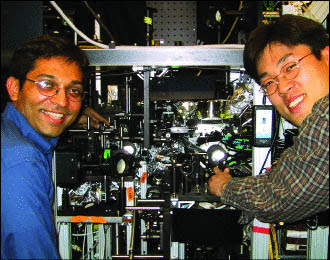
Tweezers Serve up Condensates
Hank Hogan
At temperatures just above absolute zero, normally distinct atoms collapse into each other's quantum arms, forming a single quantum wave function. These Bose-Einstein condensates could form the basis of a continuous atom laser, for example, but such applications would require a constant source of ultracold atoms. A group at Massachusetts Institute of Technology in Cambridge may have a solution in using a laser to transport condensed sodium atoms from the production chamber to where they are needed.

Graduate student researchers Ananth P. Chikkatur and Yong-Il Shin of Massachusetts Institute of Technology pose with an apparatus that serves up a continuous source of Bose-Einstein condensates. A laser transfers the sodium condensates from the production chamber to another chamber 32 cm away for storage.
Only time will tell how this advance will affect future research and applications. "This work is mainly a technological breakthrough," said Ananth P. Chikkatur, a graduate student at the school and one of the researchers on the project. "As with many things in science, a technological push can lead Essential to the technique is the use of two chambers to separate the creation and storage of the Bose-Einstein condensates. In the research, the first chamber produced the sodium condensates through a combination of laser and evaporative cooling. During the early stages of production, a closed shutter ensured that the holding chamber remained undisturbed.
After making the condensate, the researchers opened the shutter and used optical tweezers fashioned from a 50-mW, 1064-nm laser to dip into the sample and trap a few million atoms. They moved the tweezers and condensate 32 cm into a second chamber, where the transported atoms combined with any already there. They closed the shutter to shield the holding chamber and began the cycle again.
The more delicate hand of the optical tweezers offers several advantages over its magnetic counterpart. "A magnetic trap is too strong at a long range, which makes the new, incoming condensates shoot into the continuously held condensate," Chikkatur explained.
With this technique, the investigators created a continuous supply of approximately 1 million atoms. Decreasing the production time and/or increasing the storage lifetime could raise that number, suggesting avenues for future research and development.
Published: September 2002